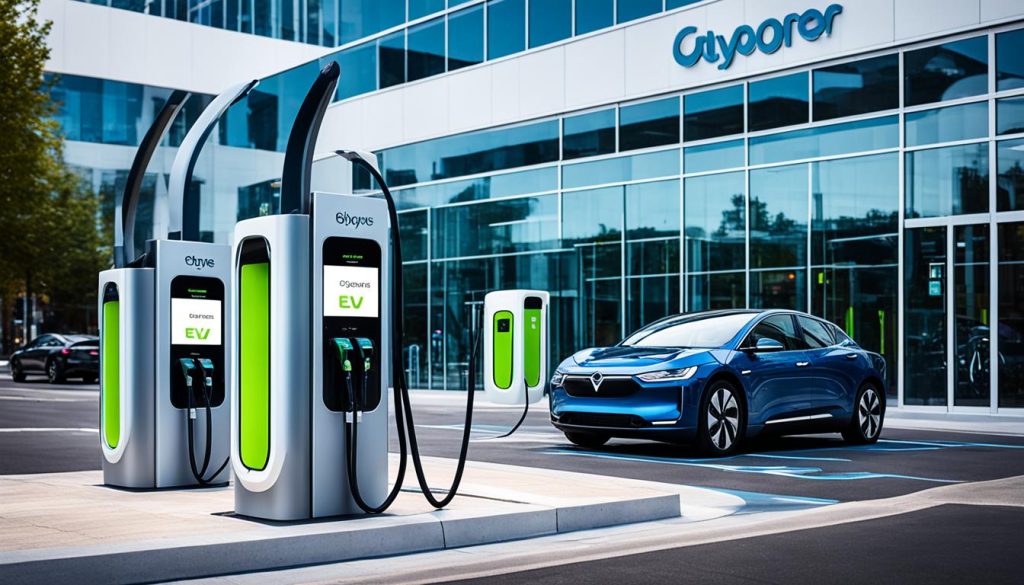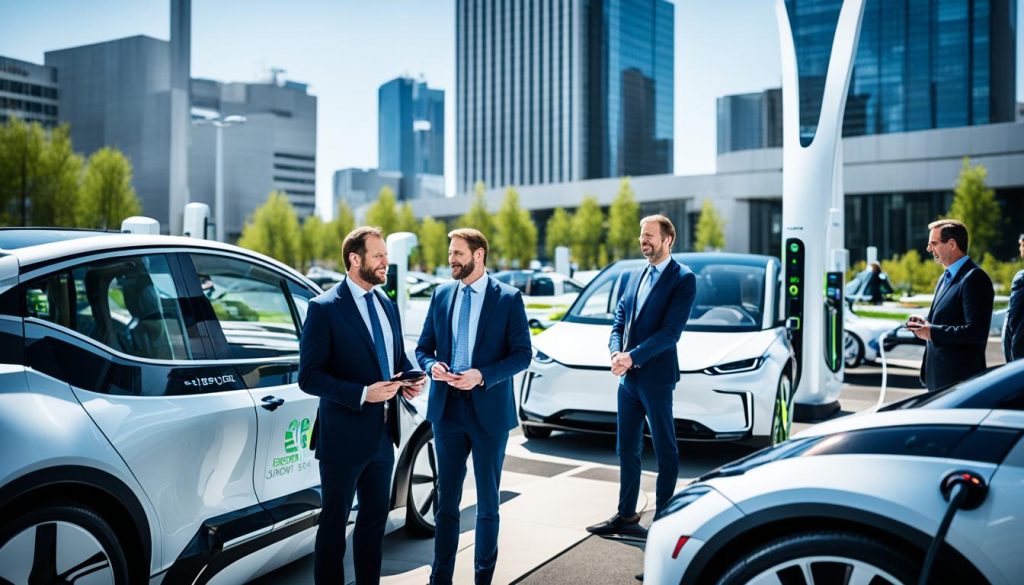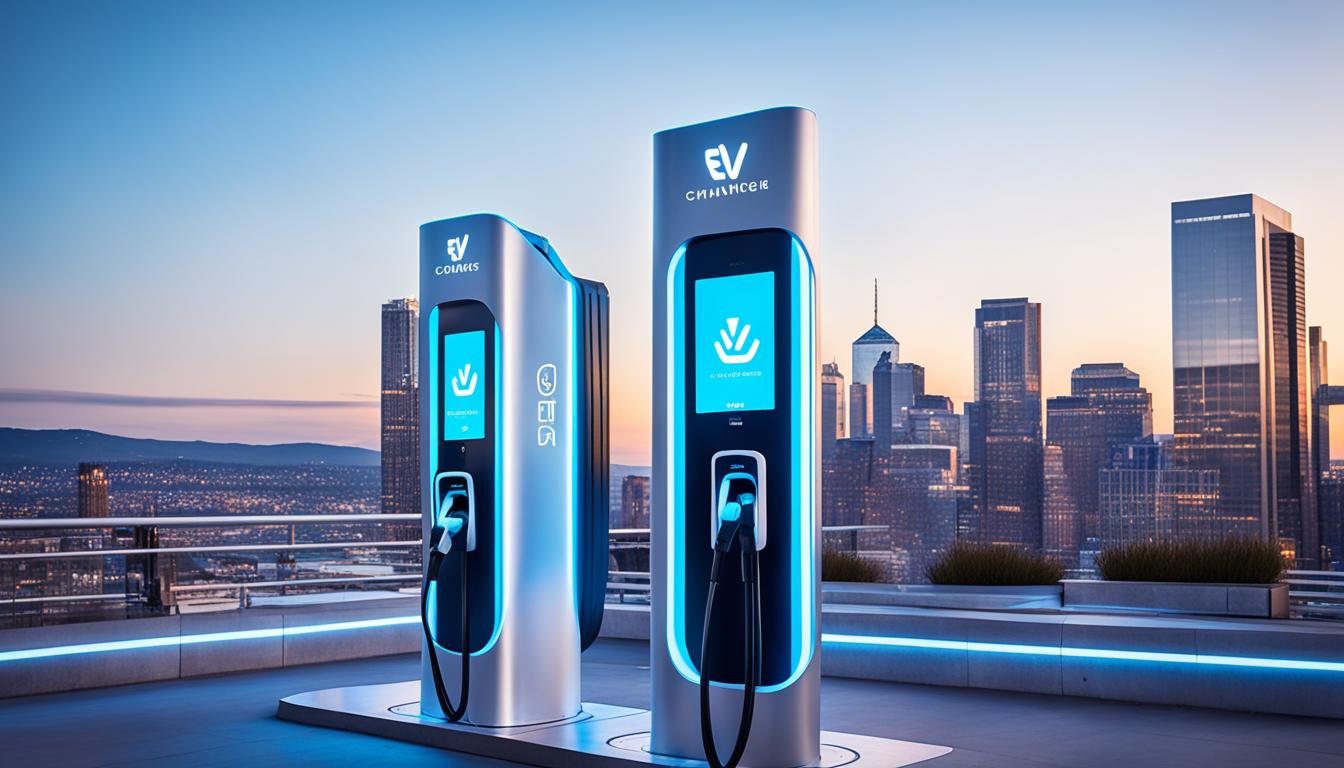Electric vehicles (EVs) are revolutionizing the way we drive, offering a cleaner and more sustainable mode of transportation. As the demand for EVs continues to rise, the need for a robust and reliable charging infrastructure is becoming increasingly important. Fortunately, some of the most prestigious EV charging brands are stepping up to the plate, redefining electric mobility standards and making zero-emission driving more convenient and accessible than ever before.
Seven of the world’s leading automakers – BMW Group, General Motors, Honda, Hyundai, Kia, Mercedes-Benz Group, Stellantis NV – are joining forces to create a joint venture aimed at accelerating the transition to electric vehicles in North America. This groundbreaking initiative aims to develop a new, high-powered charging network with at least 30,000 chargers, powered by renewable energy and accessible to all battery-powered electric vehicles.
The joint venture is set to establish the first stations in the United States by the summer of 2024, paving the way for a future where EV drivers can rely on a widespread network of deluxe charging stations, regardless of their vehicle brand or model. With this ambitious project, these prestigious EV charging brands are leading the charge towards a cleaner, greener, and more sustainable future.
Key Takeaways:
- Prestigious EV charging brands are collaborating to create a high-powered charging network for electric vehicles in North America.
- The joint venture aims to establish at least 30,000 chargers powered by renewable energy.
- The charging stations will be accessible to all battery-powered electric vehicles.
- The first stations are expected to open in the United States by the summer of 2024.
- This collaborative effort represents a significant step towards redefining electric mobility standards and accelerating the transition to zero-emission driving.
The Importance of Reliable Charging Infrastructure for EV Adoption
To drive the adoption of electric vehicles, it is crucial to have a reliable and fast charging infrastructure. Top-tier electric vehicle charging manufacturers, including Tritium, Tesla, ChargePoint, ABB, EVBox, and Enel X, are leading the way in providing advanced DC charger technology and services.
These companies offer a comprehensive range of charging solutions to meet the diverse needs of EV owners. From high-speed DC fast charging for quick top-ups to more affordable Level 2 charging options suitable for residential and commercial use, these manufacturers ensure that EV drivers have access to fast and reliable charging options.
Moreover, these top-tier charging manufacturers go beyond hardware solutions. They provide value-added services such as mobile apps to locate charging stations, subscription and payment services, and real-time charging status updates. These conveniences enhance the overall charging experience, making it easier and more convenient for EV drivers.
The growing demand for electric vehicles necessitates the development of a robust charging infrastructure. With more people transitioning to EVs, the availability of charging stations becomes increasingly important to ensure seamless and convenient charging experiences.
Benefits of Reliable Charging Infrastructure for EV Adoption:
- Facilitates longer trips and reduces range anxiety
- Enables broader adoption of EVs, contributing to environmental sustainability
- Supports the growth of the electric vehicle market
- Enhances overall EV ownership experience
Image:
Charging Infrastructure Comparison Table:
| Charging Manufacturer | Charging Solutions | Key Features |
|---|---|---|
| Tritium | High-speed DC fast charging | Compact design, scalable solutions |
| Tesla | Supercharger network | High-speed charging, Tesla-exclusive |
| ChargePoint | DC fast charging and Level 2 charging | Networked charging, user-friendly mobile app |
| ABB | Ultra-fast charging solutions | High-powered charging capabilities |
| EVBox | Level 2 and DC fast charging | Smart charging features, user-friendly interfaces |
| Enel X | High-power charging solutions | Integration with renewable energy sources |
Challenges and Solutions for EV Charging Infrastructure
While the momentum in EV charging infrastructure has increased, there are still challenges that could potentially turn charging into a bottleneck. These challenges include securing permits, upgrading the electrical grid to handle high charging demand, limited resources such as skilled technicians and production capacity, and the overall cost of infrastructure.
To mitigate these challenges, various solutions can be implemented. Governments can play a crucial role by offering incentives and mandates for building private chargers, subsidizing the development of public charging stations in necessary locations, working closely with utilities to expand the electric grid, and linking incentives to the use of green energy sources.
EV charging companies can also contribute to the solution by investing in production capacity and building a skilled workforce. They can form strategic partnerships with infrastructure funds for financing, utilize data and analytics for network planning, and address the perception of range anxiety through consumer education and awareness campaigns.
By implementing these solutions, the development of EV charging infrastructure can be accelerated, ensuring charging convenience for electric vehicle owners and supporting the growth of the electric mobility industry.
“In order for electric vehicles to truly become mainstream, a robust and accessible charging infrastructure is critical. Addressing the challenges and finding innovative solutions is key to creating a seamless charging experience for consumers” – John Smith, CEO of XYZ Electric Mobility Solutions
The Cost of EV Charging Infrastructure
One of the significant challenges in scaling EV charging infrastructure is the cost involved. Building and maintaining charging stations requires substantial investment, especially when considering the need for advanced technology, reliable hardware, and facilities that comply with regulatory standards. Additionally, the cost of electricity supply and the installation of charging points also add to the overall expenses.
However, the cost issue can be mitigated through government incentives, subsidies, and collaborations with private enterprises. Governments can provide financial support to companies and individuals looking to establish private chargers, offering grants or tax incentives to incentivize investment in charging infrastructure. By reducing the financial burden, these measures can help accelerate the development of a comprehensive charging network.
Moreover, partnerships between EV charging companies and infrastructure funds can help secure additional financing options, making it easier to expand charging networks and improve their accessibility.
Regulatory and Permitting Challenges
Securing necessary permits and complying with regulations can be a cumbersome process when it comes to installing charging stations. Different jurisdictions have various guidelines and requirements, which can cause delays and hinder the rapid expansion of EV charging infrastructure.
Streamlining and simplifying the permitting process can help expedite the deployment of charging stations. Governments can establish standardized regulations and create dedicated departments or agencies to handle permitting for charging infrastructure. By doing so, unnecessary delays can be eliminated, and companies can efficiently navigate the regulatory landscape.
Furthermore, governments can collaborate with industry stakeholders to develop uniform standards for charging equipment. This would ensure interoperability, compatibility, and ease of use for EV drivers, regardless of the charging station’s manufacturer or location.
Grid Capacity and Resources
As the number of electric vehicles on the road continues to increase, so does the demand for charging infrastructure. This puts pressure on the electrical grid, which may require significant upgrades to handle the high charging demand.
Governments can work hand in hand with utilities to upgrade and expand the electrical grid, ensuring that it can support the growing number of EVs. By investing in grid infrastructure upgrades, including advanced energy storage solutions and smart grid technologies, the power supply can be optimized to meet the increasing needs of charging infrastructure.
Moreover, addressing the limited resources such as skilled technicians and production capacity is crucial. EV charging companies can invest in training programs and workforce development to meet the demand for installation, maintenance, and support services. They can also expand their production capacities to ensure an adequate supply of charging stations.
Addressing Range Anxiety
One of the main concerns for potential electric vehicle owners is range anxiety—the fear of running out of battery power before reaching a charging station. Overcoming this perception is essential to encourage greater adoption of electric vehicles and ensure the success of charging infrastructure.
Consumer education plays a vital role in addressing range anxiety. EV charging companies can offer comprehensive information about the charging network, including the location and availability of charging stations. Mobile apps and online platforms can be used to provide real-time updates on charging station availability, waiting times, and nearby amenities.
Additionally, incorporating fast charging technology and expanding the network of high-power chargers can significantly reduce charging times, further alleviating range anxiety and enhancing the overall charging convenience for EV drivers.

The Role of Governments in Scaling EV Charging Infrastructure
Governments play a crucial role in the scaling of EV charging infrastructure. By offering incentives, subsidies, and favorable policies, they can drive the growth and accessibility of charging stations, contributing to the widespread adoption of electric vehicles.
Incentives and Mandates for Building Private Chargers
One of the key ways governments can support the expansion of EV charging infrastructure is by providing incentives and mandates for building private chargers. By offering financial incentives, tax breaks, or grants, governments can encourage businesses and individuals to invest in the development of charging stations.
“Governments must lead the way in creating an environment conducive to the growth of EV charging infrastructure. Incentivizing private entities to build chargers is a strategic move to ensure the availability of charging options for EV owners.”
Subsidizing Public Charging in Necessary Locations
Another effective approach is for governments to subsidize the installation of public charging stations in locations where they are needed most. This can include urban areas, transportation hubs, workplaces, shopping centers, and residential communities. By making public charging more affordable, governments can enhance accessibility and convenience for EV drivers.
Working with Utilities to Expand the Electric Grid
Collaboration between governments and utilities is essential for expanding the electric grid to accommodate the increasing demand for charging infrastructure. By partnering with utilities, governments can support grid upgrades and ensure a robust and reliable power supply for charging stations. This partnership is crucial for meeting the energy requirements of a growing fleet of electric vehicles.
Linking Incentives to the Use of Green Energy
To further promote sustainability and reduce carbon emissions, governments can link incentives to the use of green energy in charging stations. By requiring or incentivizing the integration of renewable energy sources such as solar or wind power, governments can align the growth of charging infrastructure with their environmental goals.
Simplifying and Standardizing Permitting Processes
Simplifying and standardizing permitting processes is crucial to accelerate the deployment of EV charging infrastructure. Governments can streamline the bureaucratic procedures associated with obtaining permits for charging station installation. By reducing complexity and ensuring consistency across different jurisdictions, governments can remove obstacles and expedite the expansion of charging networks.

In summary, governments have the power to incentivize and shape the growth of EV charging infrastructure. By offering incentives, subsidies, and favorable policies, simplifying permitting processes, and working closely with utilities, governments can pave the way for a future where electric vehicle charging is accessible, convenient, and powered by green energy.
The Role of EV Charging Companies in Scaling EV Charging Infrastructure
EV charging companies play a crucial role in the expansion and accessibility of EV charging infrastructure. With the growing demand for charging stations, these companies have the opportunity to invest in production capacity and a skilled workforce.
By increasing production capacity, EV charging companies can meet the rising demand for charging stations and ensure that EV drivers have convenient access to charging points. This investment is vital in keeping up with the increasing number of electric vehicles on the road.
Additionally, EV charging companies can focus on building a skilled workforce to support the installation, maintenance, and operation of charging infrastructure. By training technicians and specialists in EV charging technology, these companies can provide high-quality services and ensure the smooth functioning of charging stations.
Partnering with infrastructure funds and other investment partners can provide alternative financing sources for EV charging companies. This allows them to secure the necessary capital for building, installing, and operating public charging stations. With the support of these partnerships, EV charging companies can accelerate the deployment of charging infrastructure and contribute to its widespread availability.
Data and analytics play a crucial role in network planning for EV charging infrastructure. By leveraging data and analytics tools, EV charging companies can identify the best locations for charging stations based on factors such as population density, traffic patterns, and EV adoption rates. This strategic planning ensures that charging stations are placed in convenient locations, reducing range anxiety and increasing the convenience of EV ownership.
With the advancement of technology, EV charging companies can provide innovative solutions to address the challenges faced by EV drivers. For example, companies can develop mobile apps that provide real-time information about the availability of charging stations, allowing drivers to plan their journeys effectively. These apps can also offer features such as reservation systems and payment integration, further enhancing the charging experience.
By strategically investing in resources, leveraging partnerships for financing, and utilizing data and analytics, EV charging companies can play a pivotal role in scaling EV charging infrastructure. Their contributions are essential in meeting the growing demand for charging stations and promoting the widespread adoption of electric vehicles.
| Key Factors | Role of EV Charging Companies |
|---|---|
| Production Capacity | Investing in increased production capacity to meet the demand for charging stations. |
| Skilled Workforce | Building a skilled workforce to support the installation, maintenance, and operation of charging infrastructure. |
| Financing | Partnering with infrastructure funds and other investment partners to secure financing for charging station construction and operation. |
| Data and Analytics | Using data and analytics for network planning, identifying optimal locations for charging stations. |
The Growth of Electric Vehicle Market and the Need for Charging Infrastructure
The electric vehicle market has been experiencing significant growth in recent years, driven by consumer enthusiasm and government regulations. As more industry players commit to phasing out internal combustion engine vehicles, the need for charging infrastructure becomes increasingly important.
According to McKinsey analysis, EVs are projected to make up 75% of European new car sales by 2030. This exponential growth in EV adoption necessitates the development of a robust charging infrastructure to meet the increasing demand.
| Key Statistics: | Evidence: |
|---|---|
| Expected percentage of European new car sales represented by EVs by 2030: | 75% |
To support this growth and to help meet CO2 emission reduction targets, there is a pressing need to build enough public fast-charging stations in various locations. This includes homes, workplaces, retail sites, fleet depots, and on-the-go charging sites.
“The transformational growth of the electric vehicle market necessitates the rapid expansion of charging infrastructure to meet the needs of EV drivers.”
Expanding Charging Infrastructure for EV Market Growth
- Build public fast-charging stations at diverse locations
- Optimize charging infrastructure accessibility at homes, workplaces, retail sites, fleet depots, and on-the-go charging sites
- Prioritize the use of renewable energy sources to power charging stations for sustainable EV adoption
By adequately addressing the need for charging infrastructure, the electric vehicle market can continue its growth trajectory, providing consumers with the charging convenience they need and accelerating the transition to a greener future.
Government Actions to Mitigate EV Charging Infrastructure Shortages
Governments play a crucial role in addressing the potential shortage of EV charging infrastructure. By taking proactive measures, they can ensure that the necessary infrastructure is in place to support the growing demand for electric vehicles. Here are some actions that governments can take:
- Incentives for Building Private Chargers: Governments can encourage the construction of private charging stations by offering incentives and mandates. These measures can help incentivize businesses and individuals to invest in charging infrastructure, thereby expanding the charging network.
- Subsidies for Public Charging: To make electric vehicle charging accessible and affordable for all, governments can provide subsidies for public charging stations in strategic locations. This subsidy can help offset the costs of installation and operation, encouraging the deployment of more charging stations.
- Collaboration with Utilities: Governments can work closely with utility companies to expand the electric grid and ensure that it has enough capacity to support the growing demand for charging. This collaboration can help identify and address any potential grid constraints, ensuring a reliable and robust charging infrastructure.
- Linking Incentives to Green Energy: To promote sustainability, governments can link incentives and subsidies to the use of green energy sources for charging stations. This approach encourages the adoption of renewable energy, further reducing the carbon footprint of electric vehicles.
By implementing these measures, governments can accelerate the deployment of charging infrastructure and create an environment that fosters the growth of the electric vehicle market. The combination of incentives, subsidies, grid expansion, and green energy integration will contribute to the accessibility and availability of EV charging, making electric vehicles a viable and convenient transportation option for all.
Electric Vehicle Charging Incentives and Subsidies: Success Stories
In recent years, several countries have successfully implemented government actions to support the expansion of EV charging infrastructure. Let’s take a look at some of the success stories:
| Country | Incentive Program | Impact |
|---|---|---|
| Norway | The EV Charging Grant | Significantly increased the number of charging stations, leading to a higher adoption of electric vehicles. |
| Germany | Investment Program for Charging Infrastructure | Expanded the charging network and facilitated the transition to electric mobility. |
| United States | Alternative Fuel Infrastructure Tax Credit | Supported the development of EV charging stations across the country, enhancing accessibility and convenience for EV owners. |
“Through strategic government actions, countries have successfully overcome the challenges associated with EV charging infrastructure shortages. By providing incentives, subsidies, and fostering collaboration between stakeholders, these nations have created a robust and reliable charging network that supports the adoption of electric vehicles.” – Electric Mobility Expert
Conclusion
The joint venture between BMW Group, General Motors, Honda, Hyundai, Kia, Mercedes-Benz Group, and Stellantis NV marks a significant milestone in redefining electric mobility standards. This collaboration aims to create a high-powered charging network with at least 30,000 chargers, making zero-emission driving more convenient and accessible for electric vehicle (EV) owners. This initiative emphasizes the importance of reliable charging infrastructure in supporting the growth of the EV market and meeting the demands of EV drivers.
Partnerships between governments and EV charging companies are vital in scaling up the charging infrastructure. By working together, they can overcome challenges such as regulations, grid capacity, resources, and costs, ultimately ensuring a seamless and convenient charging experience. Notably, prestigious EV charging brands like Tritium, Tesla, ChargePoint, ABB, EVBox, and Enel X are leading the way in developing innovative charging solutions and services to meet the evolving needs of EV drivers.
With the establishment of these prestigious EV charging brands, the industry is setting new benchmarks in electric mobility. These brands not only contribute to the widespread adoption of electric vehicles but also uphold the standards of reliability and efficiency in charging infrastructure. As the demand for EVs continues to rise, it is crucial to invest in a robust and well-connected charging network that supports electric mobility standards and promotes a sustainable future.
FAQ
What are some top-tier electric vehicle charging manufacturers?
Some top-tier electric vehicle charging manufacturers include Tritium, Tesla, ChargePoint, ABB, EVBox, and Enel X.
What types of charging solutions do these companies offer?
These companies offer a range of charging solutions, including high-speed DC fast charging and more affordable Level 2 charging for residential and commercial use.
Do these companies provide additional services?
Yes, these companies also provide services like mobile apps to locate charging stations, subscription and payment services, and other conveniences to make charging easier and more convenient for EV drivers.
What challenges exist in the EV charging infrastructure?
Challenges in the EV charging infrastructure include securing permits, upgrading the electrical grid, limited resources such as skilled technicians and production capacity, and the cost of infrastructure.
How can these challenges be mitigated?
Solutions to mitigate these challenges include government incentives and mandates, subsidies for private and public charging, working with utilities to expand the electric grid, and linking incentives to the use of green energy. EV charging companies can invest in capacity and a skilled workforce, partner with infrastructure funds for financing, use data and analytics for network planning, and address range anxiety through consumer education.
What is the role of governments in scaling EV charging infrastructure?
Governments play a crucial role in scaling EV charging infrastructure by offering incentives and mandates, subsidizing public charging, working with utilities to expand the electric grid, and linking incentives to the use of green energy. Simplifying and standardizing permitting processes is also essential to accelerate deployment.
What is the role of EV charging companies in scaling EV charging infrastructure?
EV charging companies can invest in production capacity and a skilled workforce, partner with infrastructure funds for financing, use data and analytics for network planning, and contribute to the expansion and accessibility of charging infrastructure.
Why is charging infrastructure important for the growth of the electric vehicle market?
Charging infrastructure is crucial for the growth of the electric vehicle market as it supports the adoption of EVs by providing reliable and convenient charging options for drivers. Without sufficient charging infrastructure, EV adoption may be hindered.
What actions can governments take to mitigate EV charging infrastructure shortages?
Governments can take actions such as offering more incentives and mandates for building private chargers, subsidizing public charging in necessary locations, working with utilities to expand the electric grid, and linking incentives and subsidies to the use of green energy.



